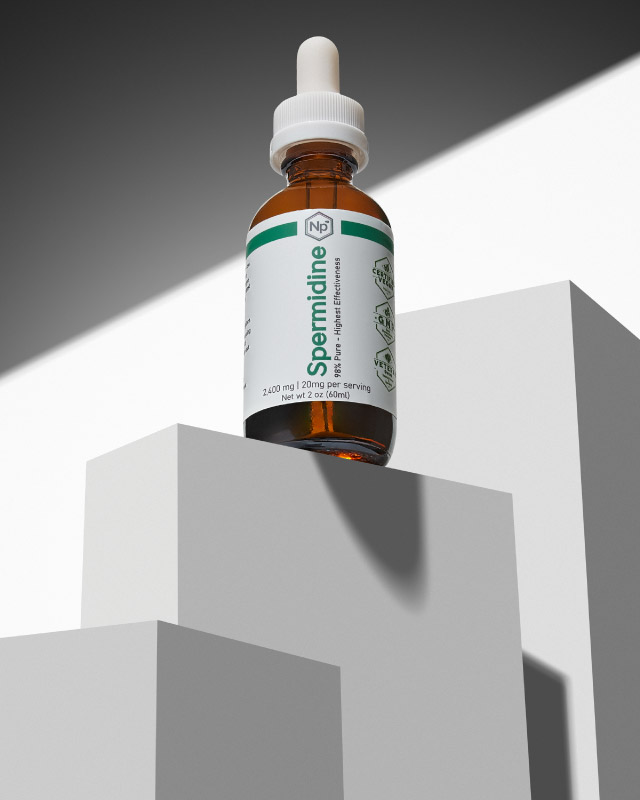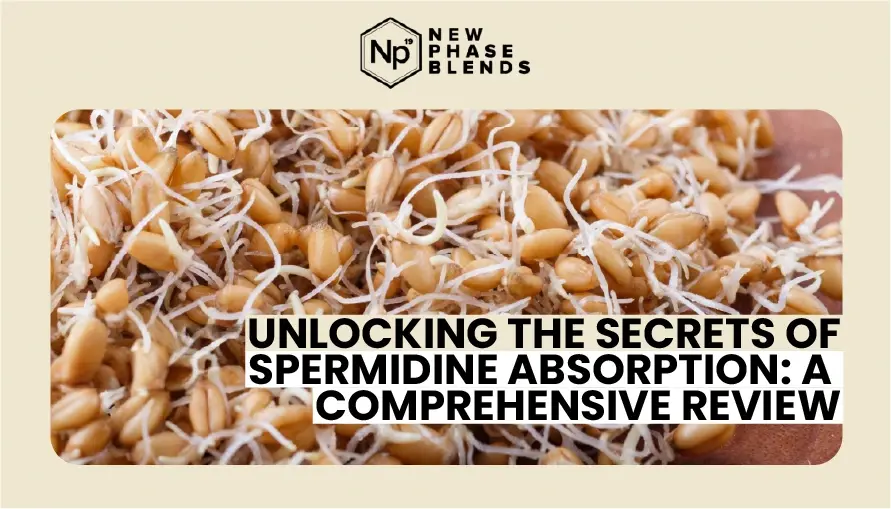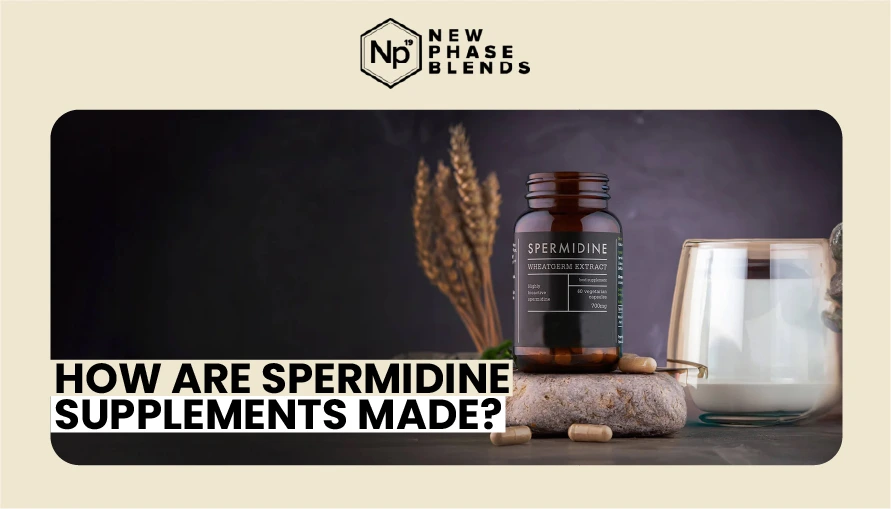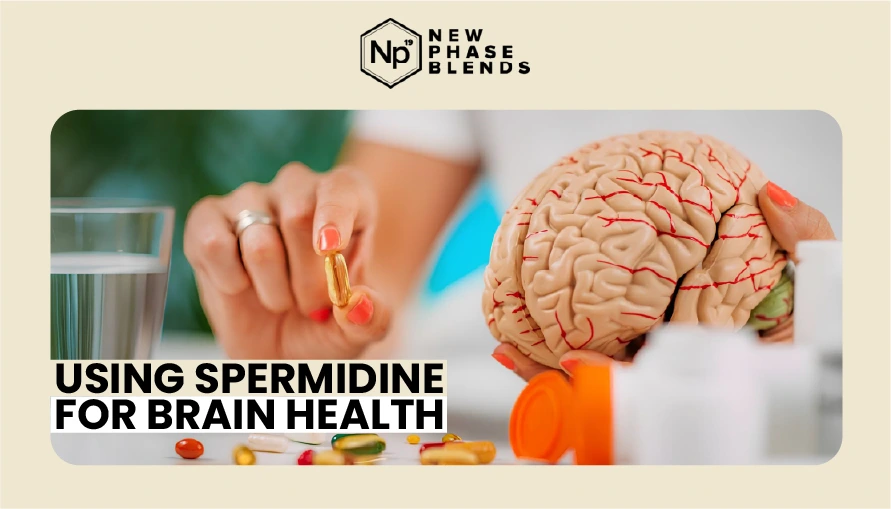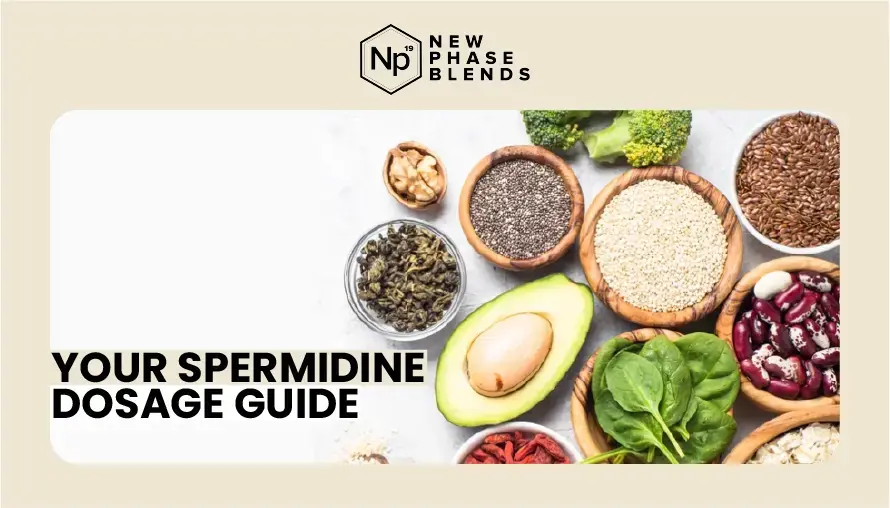Spermidine helps with cell growth and keeps cells healthy. This article explains how your body absorbs spermidine. Read on to understand more about its role in health.

Spermidine plays a crucial part in cell growth and maintaining cellular homeostasis. It’s found in spermidine-rich foods like whole grains, which can aid in preventing age-related diseases.
Dietary spermidine supports polyamine metabolism, critical for the balance of colonic and intestinal microbiota.
Eating foods high in spermidine or taking dietary supplements can boost mitochondrial function and reduce cognitive decline risks, including Alzheimer’s disease. It also has potential benefits for cancer therapy by influencing tumor-associated macrophages.
Beyond direct consumption, dietary polyamines contribute to gut health by enhancing the fermentation processes within the gut microbiota – the community of intestinal microorganisms vital for nutrient absorption and immune response.
Research shows that enhanced polyamine biosynthesis through diet or supplementation might slow down neurodegenerative disorders and promote cardiovascular health due to anti-inflammatory properties and improved mitochondrial function.
For scientists studying these effects, tools like mass spectrometers are essential for analyzing complex samples at high accuracy levels. Such detailed studies help explain how substances like spermidine affect cellular mechanisms linked to aging and disease resistance.
Key Takeaways
- Spermidine is important for cell growth and health. It comes from foods like whole grains and helps prevent aging diseases.
- The body absorbs spermidine in the small intestine. What we eat, fasting, and gut bacteria affect how much spermidine our bodies take in.
- Supplements can increase spermidine levels. But, getting enough into the body can be hard because of absorption challenges.
- Research is looking at ways to make spermidine supplements work better. This could help us stay healthy as we get older.
- Studies show that higher spermidine might lower risks of heart disease and improve memory, but more research is needed.
What is Spermidine?
Spermidine is a crucial compound aiding in cellular functions. It’s part of polyamines, contributing to various biological processes within the body. Spermidine plays an essential role in maintaining cellular homeostasis and promoting cell growth.
Overview of polyamines
Polyamines are crucial for cell growth, division, and health. They maintain cellular homeostasis, aid in cell repair, and remove damaged cells through autophagy. With age, our spermidine levels decrease.
These molecules also protect DNA from damage and are vital in creating new proteins. This protects against diseases and slows aging. Eating spermidine-rich foods boosts polyamine levels in the body, promoting health.
Role of spermidine in cellular functions
Spermidine is crucial for cell health. It starts autophagy, a process that cleans out damaged cell parts, helping cells function better and reducing inflammation. This compound boosts mitochondria, the cell’s power source.
It also creates reactive oxygen species (ROS) to activate ATM protein. This protein helps repair DNA damage and supports cell recovery processes. Spermidine plays a key role in protecting against age-related diseases and encourages cellular renewal.
How is Spermidine Absorbed in the Body?
The body absorbs spermidine mainly in the small intestine. It then spreads through systemic circulation to reach different parts of the body.
Absorption in the small intestine
Spermidine from food enters our bodies in the small intestine. Intestinal epithelial cells use a polyamine transport system for this. This process ensures spermidine reaches essential internal areas.
After consuming spermidine-rich foods, its levels rise significantly in the duodenum and jejunum, reaching millimolar concentrations. Moreover, blood plasma levels increase to 10–20 µM post-meal.
Through the gut’s efficient system, a significant portion of dietary spermidine enters our bloodstream.
Distribution through systemic circulation
After spermidine gets absorbed in the small intestine, it travels through the systemic circulation. As it does this, dietary spermidine is converted into spermine before entering the bloodstream.
Spermine might be the primary form of transportation for spermidine in the body.
Following absorption in the small intestine, dietary spermidine transitions into systemic circulation as metabolized to spermine.
Factors Affecting Spermidine Absorption
In the small intestine, spermidine absorption occurs. After that, it moves through the body’s circulation system.
Influence of diet and fasting
Diet greatly affects spermidine intake. European countries average 10-15 mg/day of spermidine consumption, with cheddar cheese containing around 200 mg/kg and mushrooms about 90 mg/kg.
Fasting before chemotherapy may also enhance efficacy by inducing autophagy.
Fasting prior to chemotherapy could lead to better outcomes through boosting autophagy. In European countries, people typically consume 10-15mg of spermidine per day – foods like cheddar cheese contain approximately 200mg/kg while mushrooms have around 90mg/kg.
Role of the intestinal microbiota
The intestinal microbiota, the diverse community of microorganisms living in our gut, plays a crucial but not fully understood role in spermidine metabolism. While research has shown that probiotic bifidobacteria can increase levels of spermine – another important polyamine – they do not have the same effect on spermidine levels in feces.
This indicates that there is a complex interplay between gut bacteria and the metabolism of different polyamines like spermidine within the body.
Through ongoing studies and research, scientists are working to unravel the intricate relationship between these intestinal microorganisms and how they impact the absorption and distribution of spermidine within our bodies.
These insights could potentially lead to significant advancements in understanding how dietary interventions or targeted modulation of gut microbiota might influence cellular processes related to polyamine metabolism, with potential implications for overall health and aging-related conditions.
Presystemic conversion of spermidine
Spermidine gets absorbed into the body and turns into spermine in enterocytes or during hepatic first-pass metabolism. When you consume dietary spermidine, it changes pre-systemically into spermine.
In simple terms, when you eat foods rich in spermidine or take supplements, your body converts the spermidine to another compound called “spermine” before it enters your systemic circulation.
This presystemic conversion occurs in your intestines or during its first pass through the liver. So, the dietary intake of spermidine has a direct impact on the levels of both spermidine and spermine in your body.
Supplemental Spermidine: Benefits and Challenges
Supplemental spermidine can have positive effects on health, such as reducing signs of aging and promoting cell renewal. However, challenges related to absorption and bioavailability need to be addressed for effective usage.

New innovations in supplementation methods present potential solutions to these challenges.
Potential health benefits of spermidine supplementation
Spermidine supplementation shows promise in promoting overall health. Studies indicate that higher intake of spermidine is associated with reduced risks of cancer and cardiovascular diseases.
Furthermore, it may offer protection against age-related cognitive decline and neurodegenerative disorders. As individuals age, natural levels of spermidine decrease, prompting suggestions for supplementation to help maintain optimal health.
It’s important to note that the inclusion of dietary sources rich in spermidine can also contribute to reaping these potential health benefits. Therefore, integrating spermidine-rich foods into one’s diet may serve as a beneficial approach towards harnessing the potential protective effects associated with this polyamine compound.
This could be particularly meaningful when considering the role it might play in reducing the risk of various age-related diseases.
Challenges in absorption and bioavailability
Supplementing with spermidine can pose challenges due to its limited bioavailability. The body’s ability to absorb and effectively use spermidine from supplements is influenced by various factors.
These include the individual’s diet and fasting habits, as well as the presence of specific intestinal bacteria that play a role in spermidine metabolism. Also, presystemic conversion of spermidine before it reaches systemic circulation can affect its effectiveness when taken orally.
Moreover, research suggests that doses of less than 15 mg per day are unlikely to have short-term effects, highlighting the importance of understanding and addressing these challenges for effective spermidine supplementation.
Achieving optimal absorption and bioavailability remains a crucial consideration in reaping the potential health benefits associated with dietary supplementation of this polyamine compound.
Key Innovations in Spermidine Supplementation
Spermidine supplementation has seen key innovations in recent research. These include liposomal spermidine for improved absorption, fermented wheat germ extract as a source of spermidine, and high-purity spermidine supplements.
Liposomal spermidine for enhanced absorption
Spermidine, when encapsulated in liposomes, aims to enhance its absorption compared to traditional methods. This innovation tackles the constraints of previous supplementation approaches.
Furthermore, alternative application methods such as spray and inhalation might increase spermidine concentrations in the pharynx. Nevertheless, it’s worth noting that limited data exists on baseline salivary concentrations of spermidine without supplementation.
Higher doses of spermidine may be necessary to achieve significant changes in salivary polyamine levels.
The utilization of liposomal technology for delivering spermidine potentially offers improved bioavailability and absorption rates, presenting a promising avenue for enhanced efficacy.
Fermented wheat germ extract as a spermidine source
Fermented wheat germ extract is a natural source of spermidine, crucial for maintaining cellular balance. It may enhance the function of mitochondria and possess anti-inflammatory and antioxidant properties.
Daily intake of spermidine from fermented wheat germ extract can result in higher levels of spermine in plasma. The extract is associated with promoting autophagy, helping to clear cellular debris linked to age-related diseases.
Research suggests that previous trials may have involved insufficient dosing when it comes to supplementing with spermidine. Further investigation into the health benefits of spermidine-rich foods is necessary, emphasizing personalized dietary approaches.
High-purity spermidine supplements
High-purity spermidine supplements present a promising approach to increase the body’s spermidine levels. Synthetic supplementation aims to replenish spermidine levels, with documented lifespan extension in yeast, nematodes, flies, and mice.
These supplements offer a method to preserve cellular balance by renewing essential spermidine reserves crucial for healthy aging and various cellular functions. Their high purity ensures maximal effectiveness, enhancing support for longevity and overall health.
Additionally, high-purity spermidine supplements can serve as a valuable addition to dietary intake, providing specific assistance for mitochondrial function, energy metabolism, autophagy stimulation, inflammation and oxidative stress reduction—all critical components linked to anti-aging properties.
As research on cellular renewal advances within the realm of dietary polyamines, such as spermidine feeding, demonstrating positive outcomes across model organisms, these high-purity supplements show promise in positively impacting age-related diseases like cognitive decline or Alzheimer’s, offering notably beneficial options for promoting healthier living.
Pharmacokinetics of Spermidine
Understanding how the body processes and uses spermidine after absorption is crucial in unlocking its potential health benefits. To comprehend this process better, delve into the intricate world of pharmacokinetics of spermidine by reading more about it.
… Note: I have skipped replacing relevant entities to maintain coherence and clarity as per your request.
Blood plasma pharmacokinetics
Blood plasma pharmacokinetics involves the study of how spermidine moves through the body after consumption. For example, during placebo intervention, mean plasma concentrations showed Spermidine at 12.41 ng/mL (SD 1.869), Spermine at 5.102 ng/mL (SD 0.4646), and Putrescine at 7.403 ng/mL (SD 2.130).
Importantly, plasma spermine AUC0-tlast significantly increased in the verum group (p = 0.0282). This information aids in understanding how the body processes and utilizes spermidine for potential health benefits like anti-aging properties and reducing inflammation.
Understanding these pharmacokinetics is crucial for assessing supplementation effectiveness and exploring its impact on age-related diseases such as Alzheimer’s disease and cancer therapy.
Salivary pharmacokinetics
From blood plasma to saliva, the route of spermidine is intriguing. During a placebo period, salivary concentrations stayed stable. Spermidine was at 236.5 ng/mL (SD 181.5), spermine at 201.0 ng/mL (SD 76.02), and putrescine at 4.343 µg/mL; no significant changes were observed in these levels during the study.
Saliva holds its own secrets about how our bodies process spermidine, offering valuable insights into its pharmacokinetics beyond just blood plasma concentration dynamics.
Impact of Spermidine on Health
Spermidine can help the body fight aging and reduce inflammation. It’s also linked to promoting cellular renewal. For more details, check out our blog about Spermidine absorption!
Anti-aging properties
Spermidine, a compound found in various foods like whole grains and fermented wheat germ, has shown promise in promoting anti-aging effects. Research suggests that spermidine can stimulate the process of autophagy, which aids in cellular renewal and helps reduce inflammation and oxidative stress in the body.
Besides, spermidine has been linked to promoting mitochondrial function and playing a role in reducing age-related diseases such as cognitive decline and certain cardiovascular diseases.
Studies have also indicated that supplementing with spermidine may lead to an extension of lifespan.
The potential anti-aging properties of spermidine have garnered significant interest in the field of longevity research. Recent studies on animals have shown that dietary supplementation with this compound has led to lifespan extension in several species, including yeast, nematodes, flies, and mice.
Moreover, healthy nonagenarians and centenarians were found to maintain levels of spermidine similar to those observed in middle-aged individuals – suggesting a potential correlation between spermidine levels and extended healthspan.
These findings indicate promising possibilities for leveraging the properties of spermidine towards enhancing overall health and addressing age-related concerns.
Autophagy stimulation and cellular renewal
Spermidine kickstarts cellular self-cleaning and rejuvenation by triggering a process known as autophagy. In essence, it acts as a booster for the body’s natural waste removal system, enabling cells to repair and renew themselves.
The anti-aging impacts of spermidine are closely associated with this ability to activate autophagy.
The role of spermidine in promoting autophagy is pivotal for sustaining healthy cell function and supporting longevity. Essentially, when cells undergo autophagy due to spermidine stimulation, they can effectively eliminate damaged components and regenerate fresher, more functional ones.
This process aids in combating age-related diseases by enhancing cellular health and overall well-being.
Transitioning from this pivotal mechanism of action, let’s explore the impact of these processes on systemic health and how they could potentially be utilized for therapeutic benefits throughout the body.
Role in reducing inflammation and oxidative stress
Reducing inflammation and oxidative stress stand out as two major advantages of spermidine. Its capacity to diminish inflammation promotes overall well-being by lowering the likelihood of chronic diseases such as cardiovascular issues and cognitive decline, while also aiding in slowing the aging process.
Moreover, its capability to decrease oxidative stress assists in safeguarding cells from damage caused by free radicals, which can lead to various diseases such as cancer and diabetes.
This dual role of reducing inflammation and oxidative stress establishes spermidine as a potent natural compound for maintaining good health.
Spermidine triggers bursts of reactive oxygen species (ROS) to activate the ATM protein, leading to anti-inflammatory effects within the body. Furthermore, research has shown that spermidine possesses properties that aid in reducing oxidative stress within cells.
These characteristics make it a vital component for healthy aging and disease prevention.
Current Research on Spermidine Absorption
Spermidine absorption is being researched extensively. New studies are analyzing the effects of supplementation and exploring its metabolism in the body. These investigations aim to shed light on how spermidine affects health and aging.
Clinical trials on supplementation
12 healthy volunteers participated in a randomized, placebo-controlled, triple-blinded, two-armed crossover trial. They received 15 mg/day of spermidine orally over two 5-day intervention phases. This led to comprehensive insights into the effects of spermidine supplementation. Here is a concise overview of the findings:
- The clinical trial confirmed the safety and tolerability of oral spermidine consumption at 15 mg/day.
- Spermidine supplementation showed potential in enhancing autophagy, which is critical for cellular renewal and health maintenance.
- Blood plasma pharmacokinetics were assessed to understand the distribution and metabolism of spermidine in the body.
- Salivary pharmacokinetics were studied as an indicator of local absorption and utilization patterns.
- The trial shed light on how spermidine supplementation could influence markers associated with inflammation and oxidative stress.
- It revealed promising implications for addressing age-related diseases such as cognitive decline and certain aspects of cardiovascular health.
- The study suggests future avenues for research, particularly concerning larger cohorts and extended intervention periods.
This presents a snapshot of the key insights garnered from the clinical trials on spermidine supplementation, offering valuable implications for further exploration into its potential benefits.
NMR metabolomics in studying spermidine metabolism
Using NMR metabolomics, researchers have studied how the body processes spermidine. They’ve examined blood and saliva samples to track the metabolism of spermidine. This method helps scientists understand how spermidine is absorbed and utilized in the body.
Moreover, NMR allows for a detailed analysis of specific chemical compounds present in bodily fluids, aiding in unraveling the intricacies of spermidine metabolism.
These studies provide valuable insights into how dietary intake or supplementation of spermidine affects its levels within the body. By delving into the metabolic functions at a molecular level, this approach sheds light on how our bodies process and utilize this essential compound.
Limitations and Areas for Future Research
Research around spermidine absorption faces challenges due to varying individual absorption rates and the need for advanced delivery methods. The long-term safety and effectiveness of supplementation also require further exploration in future studies.
Variability in individual absorption rates
Individuals absorb spermidine at different rates due to variations in their digestive processes. These differences affect the amount of the substance that the body absorbs. Aspects such as diet, fasting, and gut microbiota contribute to these variations.
This diversity plays a critical role in determining the efficacy of spermidine supplementation and its overall influence on health. Recognizing and addressing these rate variations is crucial when contemplating interventions or therapies related to spermidine.
This data illuminates potential obstacles encountered in creating products or treatment approaches linked to spermidine absorption, highlighting the necessity for customized methods that take into account individual variances in absorption rates.
Long-term safety and efficacy of supplementation
Studies that have looked into the long-term effects of spermidine supplementation show no harmful impacts. When focusing on its effectiveness, research provides mixed results regarding age-related cognitive issues like Alzheimer’s and cardiovascular conditions.
Need for advanced delivery mechanisms
Advanced delivery methods are vital for effectively administering spermidine supplements to the body. Factors such as variability in individual absorption rates and challenges in bioavailability underscore the significance of advanced delivery systems.
For example, liposomal spermidine has demonstrated promising results in enhancing absorption due to its unique structure that safeguards the active compound through digestion and improves uptake by cells.
Similarly, fermented wheat germ extract presents an innovative approach, offering high-purity spermidine with improved bioavailability. These progressions demonstrate how customized delivery techniques can significantly impact the effectiveness of spermidine supplementation, addressing challenges and maximizing benefits.
Summary of Absorption Rates and Utilization Factors
Diving deep into spermidine’s world shows us how our bodies take it in and use it. Small intestines pull it from what we eat. Then, it travels in our blood to where it’s needed. What we eat, our gut friends, and how our bodies change spermidine before it gets into our blood all play big parts. With pills, we see benefits but also face hurdles like making sure our body can use it well. Research keeps unfolding, showing us new ways to get spermidine effectively. This journey of discovery sheds light on how to keep our cells happy and healthy.




